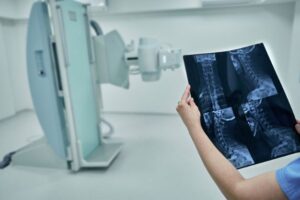Telereporting for Rural Areas:

In recent years, the landscape of healthcare has transformed through technological advancements, particularly in radiology. One significant innovation is telereporting, which provides crucial support to healthcare providers and patients in underserved areas, especially rural regions. This blog explores the importance of remote reporting, how it enhances healthcare delivery, and its role in addressing the unique challenges faced by rural communities.
Understanding Telereporting
Telereporting involves the transmission of medical images and data from one location to another for diagnostic purposes. This process is facilitated through advanced telecommunications technologies that enable radiologists to interpret images remotely, regardless of their physical location. The benefits of these services are manifold, particularly for rural areas that often face limitations in accessing specialized medical care.
The Need for Remote Reporting in Rural Areas

- Limited Access to Specialists: Rural healthcare facilities frequently lack on-site radiologists, leading to delays in diagnosis and treatment. Remote imaging bridges this gap by connecting local healthcare providers with specialists who can review images and provide reports in real-time.
- Improved Patient Outcomes: Timely access to radiological interpretations can significantly impact patient outcomes. Delays in diagnosis can worsen health conditions, especially in critical cases like stroke or trauma. Remote reporting enables prompt analysis, essential for initiating appropriate treatment.
- Cost-Effectiveness: Establishing a full-time radiology department in rural hospitals can be financially unfeasible. Remote services allow these facilities to utilize expert radiologists without the associated overhead costs.
- Enhanced Collaboration: By leveraging remote reporting, healthcare providers can collaborate more effectively. Local physicians can discuss cases with radiologists, facilitating better treatment plans tailored to individual patients.
How Remote Reporting Works

The workflow of telereporting typically involves the following steps:
- Image Acquisition: Medical images are captured using modalities such as X-rays, CT scans, or MRIs at local healthcare facilities.
- Transmission: The acquired images are securely sent to a centralized radiology center using HIPAA-compliant communication protocols.
- Interpretation: Qualified radiologists review the images and generate reports based on their findings. This process can occur within minutes, depending on the urgency of the case.
- Reporting: The final report is sent back to the local healthcare provider, often integrated into the patient’s electronic health record (EHR) for easy access.
- Follow-Up: Providers can discuss the results with patients and plan further treatment based on the radiologist’s recommendations.
The Role of Medical Document Sorting
An integral aspect of implementing remote services is effective medical document sorting. This process involves organizing and managing medical records and imaging data to ensure seamless communication between healthcare providers and radiologists. Efficient document sorting can enhance the speed and accuracy of reporting by:
- Streamlining Workflow: Organized documentation allows radiologists to access relevant patient history and previous imaging studies quickly, aiding in accurate interpretations.
- Reducing Errors: Well-sorted documents minimize the risk of mistakes, ensuring that radiologists review the correct images and reports.
- Facilitating Compliance: Proper document management is essential for maintaining HIPAA compliance, safeguarding patient privacy, and ensuring that sensitive data is handled appropriately.
Challenges in Rural Healthcare and Solutions

Despite the clear benefits of telereporting, several challenges persist in rural healthcare that need addressing:
- Technological Limitations: Many rural facilities may lack the necessary infrastructure to support advanced telehealth solutions. Investing in reliable internet connections and modern imaging equipment is crucial for enabling these services.
- Training and Support: Healthcare providers in rural areas may require training to effectively use telereporting systems. Offering educational resources and technical support can empower local staff to leverage these technologies fully.
- Regulatory Hurdles: Navigating regulatory requirements can be complex, especially for healthcare providers unfamiliar with telehealth practices. Ensuring compliance with both state and federal regulations is essential for successful implementation.
Case Studies: Success Stories of Telereporting

Several healthcare systems have successfully implemented remote services to improve patient care in rural areas. For instance:
- Case Study 1: A rural hospital in Texas partnered with a telereporting service to enhance its imaging capabilities. By utilizing remote radiologists, the facility reduced its turnaround time for reports by 50%, leading to quicker diagnoses and improved patient outcomes.
- Case Study 2: In a community in Kentucky, local physicians utilized remote services to connect with specialists from urban centers. This collaboration resulted in better management of complex cases and increased patient satisfaction due to timely care.
The Future of Telereporting in Rural Healthcare

The future of remote reporting in rural areas looks promising, with advancements in technology continuing to evolve. Emerging trends include:
- Artificial Intelligence: AI is increasingly being integrated into radiology workflows, aiding in detecting anomalies more accurately and efficiently. This technology can further enhance the capabilities of remote services.
- Mobile Health Solutions: With the rise of mobile health applications, remote imaging and reporting can become even more accessible. Patients may be able to receive consultations and interpretations from the comfort of their homes.
- Expanded Access: As telereporting becomes more widely adopted, it will open up opportunities for improved healthcare access in even the most isolated communities.
Conclusion

Contact For Tele Reporting Services
In summary, telereporting for rural areas is a transformative approach that addresses the healthcare gap through remote imaging solutions. By facilitating timely access to radiological interpretations, these services enhance patient outcomes and reduce the burden on local healthcare providers. Coupled with effective medical document sorting, telereporting can streamline processes, ensuring that patients receive the best possible care.
As healthcare continues to evolve, embracing technologies like telereporting will be critical in making quality medical care accessible to all, particularly in underserved rural regions. With the right support and infrastructure, remote reporting has the potential to revolutionize radiology in healthcare, paving the way for a healthier future for everyone.

